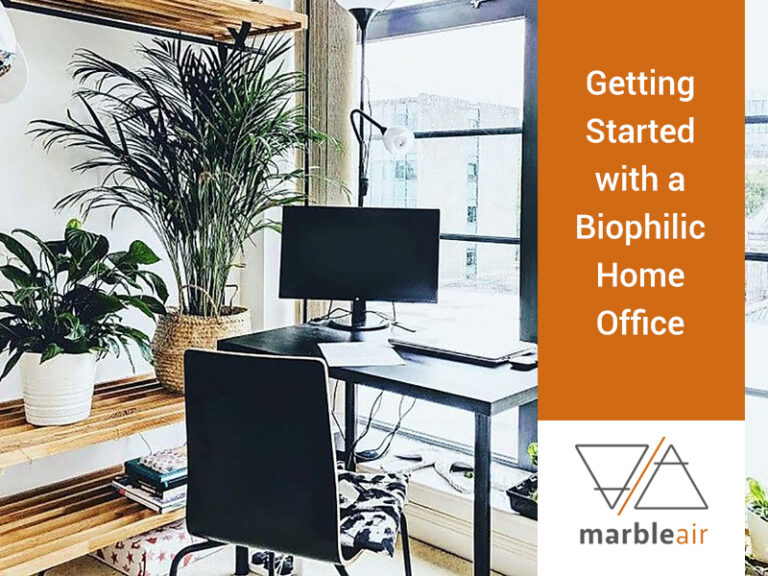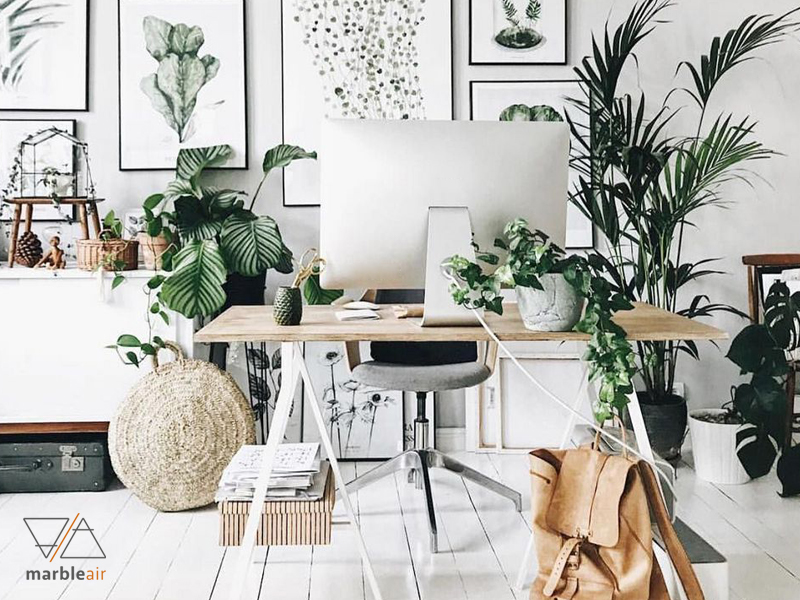
Getting Started with a Healthy & Living Biophilic Home Office
As a species, we are nothing if not adaptable. Whilst in the grip of a global pandemic businesses large and small made an almost overnight transition to remote working, and home was the new office.

There has certainly been a steady move toward more employees working from home over the past few years. However, the current situation has fast-forwarded this concept and opened the door to a keen interest in designing the most practical and comfortable home office that we can manage in our space.
One of the challenges of a home office lies in the lack of privacy because our domestic lives can quickly spill over into our work lives. Yet, we don’t want to end up stuck in a cupboard under the stairs – so what is the solution?
What is Biophilic Design?
The term ‘biophilic’ is not commonly used, but it is easily understood.
Biophilia refers to the inherent human affinity for all things natural, defined by psychoanalyst Erich Fromm as the “passionate love of life and of all that is alive…whether in a person, a plant, an idea, or a social group.”
Scientists have commented that biophilia is not only physiological but is actually genetic – a basic human need which we continue to try and satisfy.
An article unpacking biophilic design says, “Biophilic design, an extension of biophilia, incorporates natural materials, natural light, vegetation, nature views and other experiences of the natural world into the modern built environment.”
Wikipedia weighs in with the comment, “Used at both the building and city-scale, it is argued that this idea has health, environmental, and economic benefits for building occupants and urban environments, with few drawbacks. Although its name was coined in recent history, indicators of biophilic design have been seen in architecture from as far back as the Hanging Gardens of Babylon.”
Studies have shown that making use of biophilic design in an office boosts cognitive performance, and makes the occupants happier and more energised.
A space which makes us happy, productive and calm must surely be the best choice for a home office.
The Living and Natural Home Office
We may be limited by space or finances when it comes to designing the perfect home office. However we’d like to offer some suggestions on how you can design an office space cost-effectively.
Designing your space – indoors
Most rooms or indoor spaces can be transformed into an energising and inspiring office with a little research.
Furniture
Bamboo, rattan and wood paired with tactile fabrics such as linen or wool are excellent options for office furniture with their grain, knots and natural patina. They tend to be warm and welcoming minus the impersonal feel of synthetic products.
Plants
Indoor plants give an immediate lift and offer gentle energy to a room. They clean the air and can satisfy our sense of sight and smell as we go about our business. Ferns, lilies, palms or woody herbs will add to our feeling of wellbeing in even the smallest space.
Natural light
A window allowing natural light is first prize – the bigger the better. When planning your room, ensure that you keep large items of furniture away from the window so that they don’t block the light. Where possible, use light window treatments and add mirrors to bounce the natural light around the room.
Fresh air, natural scents, outdoor sounds, floral patterns and other organic elements, coupled with a clean and uncluttered design form the perfect conduit to our environment.
External alterations to enlarge an existing opening or insert new glazing are a fairly straightforward change. They are either a permitted development or can be permitted via an easy planning application process.
Designing your space – outdoors
Are you fortunate enough to have an outdoor building which can be repurposed into a home office? Or, perhaps you have a quiet space in the corner of your garden in which you are able to build a small pod-style office or garden room?
Creating a green office from scratch is incredibly exciting – especially for us creative types!
Green buildings
Starting from ground zero, so to speak, allows you to build a ‘green’ structure, making use of natural and recycled materials for a truly healthy building.
Shapes
Green and living buildings resist sharp angles and straight lines, and instead lean towards gentle arches, flowing lines and smooth edges. These organic references allow our eye to rest easily on the structure and follow the flow into the vegetation surrounding it.
Light and colour
Large windows and door openings will allow the sunlight to flood into your home office, working with your body’s natural rhythms to keep you alert and focused during the day.
Your designer may make use of earthy tones, soft greens or bright florals to keep the interior interesting and invigorating, perhaps using lighting which mimics the dappled shade of leafy trees.
Views and vegetation
Even the smallest of pod-style home offices can feel spacious when it enjoys a view. You may not have a 180° view of the ocean but looking out onto a pretty cottage garden or a field of sheep can be just as therapeutic.
Water features outside the window, wind chimes or even a small fish tank all work to bring the beauty of the outdoors in.
Architects who specialise in green buildings will enjoy working with you to create a wholesome space which is healthy, energy-efficient, environmentally responsible and incredibly comfortable.
Create Your Healthy Home Office
Have you found yourself thrust into a remote role and need a private and inspirational home office?
There’s no doubt that a healthy and green home office is the best investment that you can make; your productivity, your health and your colleagues will thank you for it.
Please contact Anna and the MarbleAir team who would love to assist you with the design of either an outdoor home office or the interior design of your indoor space.
